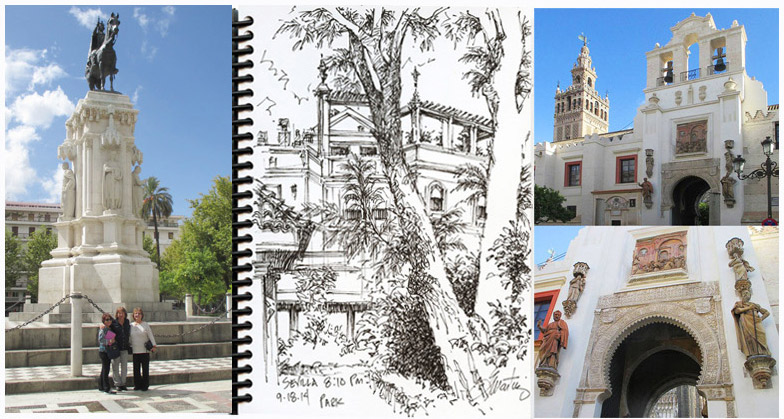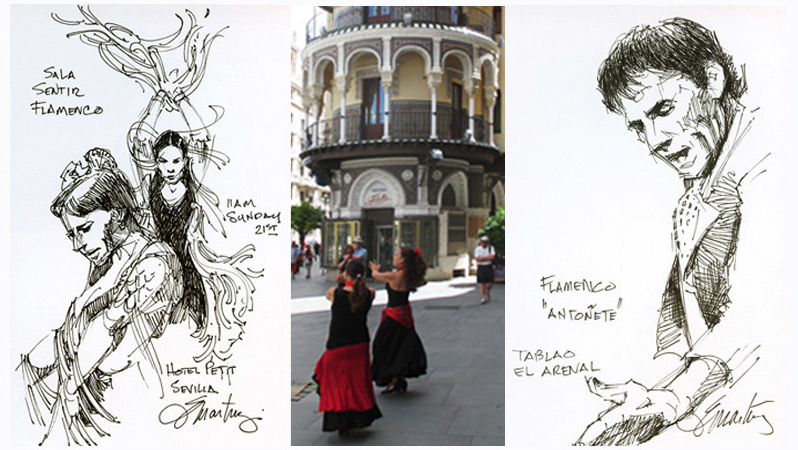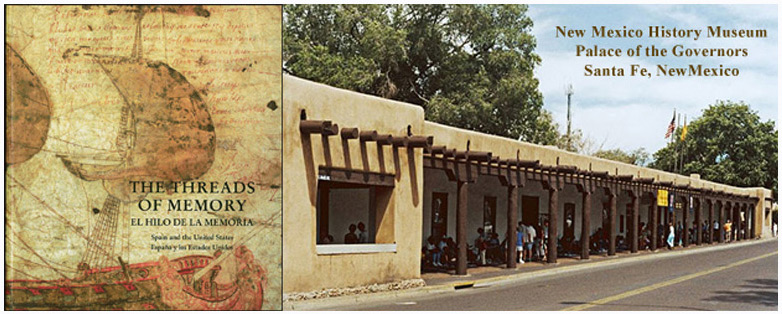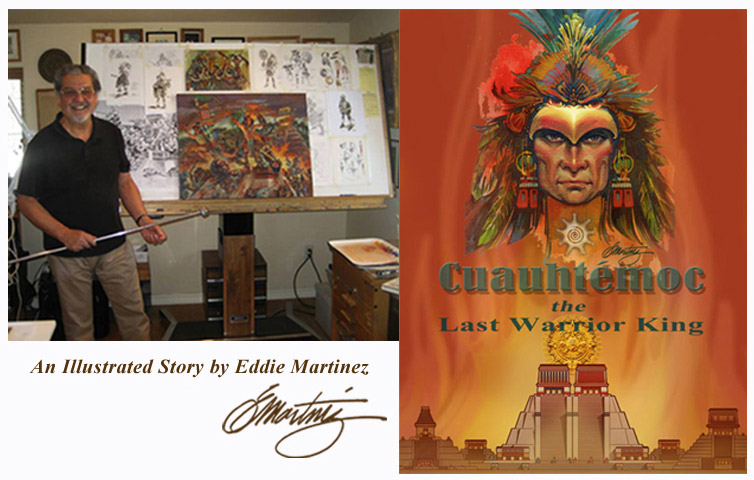Part 2 February 2015, Sevilla, Spain and Santa Fe, New Mexico
By Eddie Martinez, Somos Primos article
ART, HISTORY & CULTURE:
Walking the streets of Spain while sketching and listening for voices from the past
Bv Eddie Martinez, edited and translated in Spanish by V iola Rodriguez Sadler

ARTE, HISTORIA & CULTURA:
Caminando por las calles de Espaha dibujando y escuchando las voces del pasado
Por Eddie Martinez, editado y traducido al espanol por Viola Rodriguez Sadler
At last after so many years I was finally here in Andalusia’s beautiful historical Sevilla. Some of the sights we visited were (below left to right), the Plaza Nueva’s baroque Monument to San Fernando - (Photo, left to right are Ettamae Carter, my sister Irene Oropeza and my wife Jessie); A sketch I made of the Jardines de Los Reales Alcazares while we were resting in the park, and two photographs of the Arabic and Spanish ornate facade of the Puerta del Perdón of the Cathedral.

Por fin después de tantos años, yo estaba finalmente aquí en la bella histórica Sevilla de Andalucía. Algunos de los lugares que visitamos (arriba de izquierda a la derecha), el monumento a San Fernando estilo barroco en la Plaza Nueva - (Foto, de izquierda a derecha son Ettamae Carter, mi hermana Irene Oropeza y mi esposa Jessie); un dibujo que hice de los Jardines de Los Reales Alcázares mientras que descansábamos en el parque, y dos fotografías de la ornamentación árabe y española de la fachada de la Puerta del Perdón de la Catedral.
Flamenco: You can still see the culture of the Moors in Spain through its architecture, language, customs, and tradition in bullfighting and gypsy Flamenco music. Flamenco originated in the region of Andalusia and was influenced by the native Andalusian, Islamic, Sephardic, and Gypsy cultures that existed in Andalusia prior to and after the Reconquista.Ref: History of Seville, Spain

El Flamenco: aún se puede ver la cultura de los Moros en España a través de su arquitectura, la lengua, las costumbres y la tradición de toros y la música gitana para el flamenco. El flamenco tiene su origen en la región de Andalucía, se vio influenciado por los nativos Andaluz, islámica, sefardí, y las culturas gitanas que existían en Andalucía antes y después de la Reconquista. Ref: History of Seville, Spain
My imagination was stimulated by what it must have been like when Sevilla was Europe’s richest port city on the banks of the Río Guadalquivir, the virtual waterway to the Americas. In the photo below on the right is a view of the Cathedral that was built with a beautiful minaret in 1198. The cathedral’s Spanish bell tower was added in the 16th century.

Mi imaginación se vio estimulado por como debe haber sido cuando Sevilla era la ciudad portuaria más rica de Europa a orillas del Río Guadalquivir, la navegación virtual hacia las Américas. En la foto de arriba a la derecha, una vista de la catedral que se construyó con un hermoso alminar en el año 1198. El campanario español de la catedral se añadió en el siglo XVI.
I found this most interesting when I read Robert Goodwin as he describes Sevilla in his book, Crossing the Continent 1527-1540: The Story of the First African American Explorer of the American South: “The merchants and contractors of the sixteenth-century Seville conducted their business in and around the cathedral. They gathered on a continuous flight of steps called the gradas, which today still encircle the massive Gothic church, as though trying to raise something sacred above the profane street life. Ironically, these iconic steps provided those businessmen with a sort of sanctuary from the profanity of local taxes, because technically, the gradas were within the precincts of the Cathedral and so came under the jurisdiction of the church, and not the city hall, …” Goodwin continues, “… Among the Spaniards there were Germans, Flemings, and Frenchmen traders and hopefuls from all across Europe.”

He encontrado este más interesante cuando leí como Robert Goodwin describe Sevilla en su libro, Cruzando el Continente 1527-1540: La historia del primer explorador afroamericano del Sur de Estados Unidos: "Los comerciantes y contratistas del siglo xvi de Sevilla realizaban sus negocios en y alrededor de la catedral. Ellos se reúnen en un vuelo continuo de escalones llamado las gradas, que todavía hoy rodean la gran iglesia gótica, como si estuviera tratando de plantear algo sagrado por encima de la vida profana en la calle. Paradójicamente, estos escalones facilitaron a los empresarios con una especie de santuario de la irreverencia de los impuestos locales, porque técnicamente, las gradas estaban dentro del recinto de la Catedral y en la jurisdicción de la iglesia, y no el ayuntamiento, …" Goodwin continua, "… Entre los españoles, había alemanes , flamencos, franceses y los comerciantes y aspirantes de toda Europa."
Archivo de Indias: In 1785, Charles III ordered all of the documents of the New World to be stored there in a newly constructed building.
 Archivo de Indias: En 1785 Carlos III ordenó que todos los documentos pertinente al Nuevo Mundo se almacenaran en el edificio recién construido.
Archivo de Indias: En 1785 Carlos III ordenó que todos los documentos pertinente al Nuevo Mundo se almacenaran en el edificio recién construido.
Below are two photographs I took of a scaled drawing and model ship by artist and jeweler, Avedis Kendir of Columbus’ ship, La Santa María as well as a large oil painting of the well-known Hernán Cortés.
 Arriba las dos fotos que tomé de un dibujo escalado y el barco modelo por el artista y joyero Avedis Kenir del barco de Colón, La Santa María, así como un óleo grande del muy conocido Hernán Cortés.
Arriba las dos fotos que tomé de un dibujo escalado y el barco modelo por el artista y joyero Avedis Kenir del barco de Colón, La Santa María, así como un óleo grande del muy conocido Hernán Cortés.
During my visit there I recalled that in 2010, Jessie and I visited the New Mexico History Museum Palace of the Governors in Santa Fe where Spain exhibited rare Spanish Documents from the Archive of the Indies along with interesting keynote speakers on a series of lectures based on the beautiful publication, The Threads of Memory: Spain and the United States describing Spain’s contact with Native Americans, explorations and Spanish settlements that lead to Spain’s assistance in the American Revolutionary.

Durante mi visita allí recordé que en 2010, Jessie y yo visitamos Santa Fe, Nuevo México el Palacio de los Gobernadores, Museo de Historia donde España expuso documentos raros españoles del Archivo de Indias con oradores principales interesantes sobre una serie de conferencias basadas en la publicación hermosa, Los Hilos de Memoria: España y los Estados Unidos que describen el contacto de España con Indios Americanos, exploraciones y los establecimientos españoles que conducen a la ayuda de España en el Revolución Americana.
1587, Pedro de Unamuno arrives in California at 36° latitude from Manilla [Manila, Philippines] and skirts the coast, finding Drake’s Bay. Book ref: The Threads of Memory: Spain and the United States, Coastal Exploration Atlantic and Pacific. Page 50
Below left is the account of the request made by Sebastián Vizcaino to the king of Spain to make the journey to the Californias, leaving from Acapulco in the month of March 1598. Below right is the map of the discovered coast by Sebastián Vizcaino from the port of Navidad to Cape Mendocino. Book ref: The Threads of Memory: Spain and the United States, Coastal Exploration Atlantic and Pacific. Page 47
1587, Pedro de Unamuno llega a California en 36 grados de latitud de Manilla [Manila, Filipinas] y bordea la costa, encontrando la bahía de Drake. Ref. del libro: El Hilo de la Memoria: España y los Estados Unidos, Página 50
Arriba a la izquierda cuenta la solicitud formulada por Sebastián Vizcaíno al rey de España para hacer el viaje a las Californias, saliendo de Acapulco en el mes de marzo del 1598. A la derecha está el mapa de la costa descubierta por Sebastián Vizcaíno desde el puerto de Navidad hasta Cabo Mendocino. Ref. del libro: El Hilo de la Memoria: España y los Estados Unidos, Página 47
Below on the left is my painting of Columbus’ fleet featuring his flagship, the Santa Maria. On the right is another of my paintings of a 16th century Spanish Manila galleon they may have possibly anchored somewhere near Bolsa de Gengara or Newport Beach, seeking food, and fresh drinking water after crossing the Pacific Ocean from the Philippines. I portrayed what may have been an encounter of the Kengaaor Genfara of Tongva-Gabrielino people with the Spanish sailors in the Los Angeles region.

Arriba a la izquierda es mi pintura de Colón con su buque insignia, la Santa María. A la derecha es otra de mis pinturas de un galeón Manila español del siglo XVI que puedan haber anclado en algún lugar cercano a Bolsa de Gengara o Playa de Newport, en busca de alimentos, agua potable después de cruzar el Océano Pacífico desde las Filipinas. He descrito lo que podría haber sido un encuentro de los Kengaaor Genfara de Tongva-Gabrielino con los marinos españoles en la región de Los Ángeles.
Below is the 1787 map of Lower and Upper California by Diego Trancoso that pictures an engraving on paper from the Sevilla’s Archivo General de Indias published in, The Threads of Memory: Spain and the United States. My interest in early California includes my researching and illustrating the images of Catalonian De Portolá, Governor of Baja California when he marched north in 1769 to modern-day bay of San Francisco. On the right, is a figure ink drawing of a Yang-na hunter of the Tongva-Gabrielino tribe.

Arriba se muestra el mapa de 1787 de Baja y Alta California por Diego Trancoso que enseña un grabado sobre el papel del Archivo General de Indias de Sevilla publicado en The Threads of Memory: Spain and the United States. Mi interés en la vieja California incluye mi investigación e ilustrando las imágenes del Catalán De Portolá, Gobernador del Estado de Baja California cuando se marchó al norte en 1769, hasta las operaciones modernas de la bahía de San Francisco. A la derecha, es una figura dibujo de tinta de un cazador Yang-na de la tribu Tongva-Gabrielino.
In the afternoon we enjoyed walking the picturesque streets viewing the many Moorish Gothic buildings and later we had dinner in a small kitchen restaurant that was a block away from our hotel, the Petit Palace Marques Santa Ana. I ordered topas; Jamón con queso with quail eggs on top. In the photograph below on the right the jamón serrano (cured ham) can be seen hanging in the corner of the wall, it was very good. And so, it had been another wonderful day enjoying the sights and friendly people in Sevilla.

Por la tarde disfrutamos caminando por las calles pintorescas viendo muchos edificios moros góticos, y más tarde nos fuimos a cenar en un pequeño restaurante que estaba a una manzana de distancia de nuestro hotel, el Hotel Petit Palace Marqués Santa Ana. Ordené tapas; Jamón con queso con huevos de codorniz en la parte superior. En la fotografía de arriba a la derecha el jamón serrano (jamón curado) puede verse colgado en una esquina de la pared, estuvo muy bueno. Y así, había sido otro día maravilloso disfrutando de los paisajes y gente amable en Sevilla.
In my next March article I will be featuring the marine museum in the Torre del Oro or the Tower of Gold where there are exhibits of maps, paintings, model ships, and sailors from the 16th to the 18th century.
En mi próximo artículo en marzo incluyeré el museo de marina en la Torre del Oro donde se exhiben mapas, pinturas, modelos de barcos, y marineros de los siglos XVI hasta XVIII.
Cuauhtémoc, the Last Warrior King

